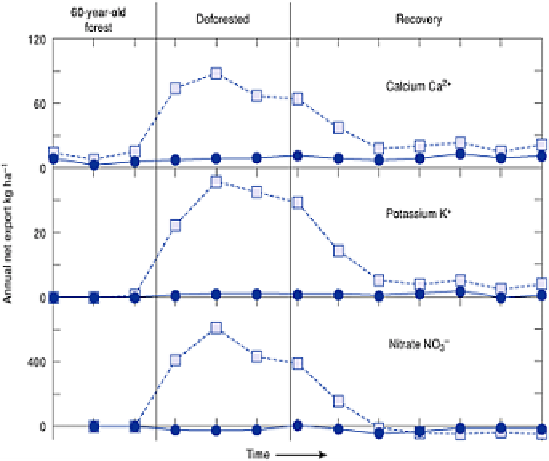Environmental Engineering Reference
In-Depth Information
the exchange sites on the soil colloids. These soils are associated with low base
saturation, and the availability of calcium, magnesium and potassium is much lower in
acid soils than in near-neutral or alkaline soils.
In their studies of the calcium cycle in the natural forest of Hubbard Brook, Bormann
and Likens discovered that the forest ecosystem is extremely conservative in its nutrient
cycling. The precipitation input of calcium of 2·6 kg ha
−1
yr
−1
is matched by a loss in
stream output of only 12 kg ha
−1
yr
−1
of calcium. This is a small rate of loss considering
the large amounts of calcium in the calcium stores of the watershed, and is probably
balanced by 9·1 kg ha
−1
yr
−1
released by weathering. The main stores and flows of
calcium in Hubbard Brook are illustrated in Figure 22.9. The conclusion is that natural
ecosystems have many nutrient-conserving mechanisms - in the living biomass, in the
soil and in the micro-organism population. They result in the nutrients being recycled in a
very efficient and tight manner. One effect of human interference is to break such
conservational cycles and to cause serious depletion of nutrients from the ecosystem. As
part of their experimental work in the Hubbard Brook catchment Bormann and Likens
experimentally clear-cut several small watersheds and monitored dissolved nutrients in
the stream water. The results are shown in Figure 22.10. The low figures in the sixty-
year-old forest are increased enormously upon deforestation. This is due to the increased
mineralization of litter and plant debris, the elimination of plant uptake, and the
destruction of the buffering power of soil humus colloids. With time, recovery will be
brought about by the reinvasion of the cleared sites by ground vegetation, shrubs,
seedlings and ultimately trees. The vegetation will eventually re-establish the nutrient
cycles and lead once more to nutrient conservation. Temperate forests such as those of
Hubbard Brook have the main store of nutrients in the litter layer, slightly less in the
living biomass of trees, shrubs and ground vegetation, and even less on the soil colloids.
This is particularly so when

